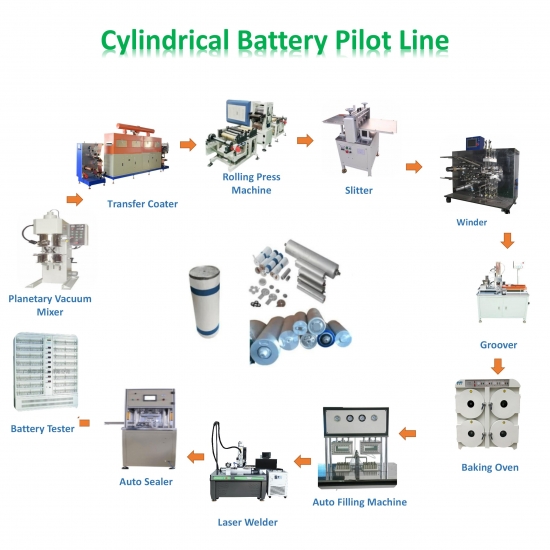Cylindrical Cell Assembly Line: Streamlining Battery Production
A cylindrical cell assembly line is a highly automated production system designed to manufacture cylindrical battery cells, commonly used in applications such as electric vehicles (EVs), portable electronics, power tools, and energy storage systems. Cylindrical cells, with their robust structure and standardized dimensions (e.g., 18650, 21700), are popular due to their efficiency in manufacturing and reliability in various applications.
● Key Processes in a Cylindrical Cell Assembly Line
1. Electrode Preparation
- Mixing: The active materials (typically lithium-ion-based for the cathode and graphite for the anode) are mixed with binders and conductive additives to form slurries.
- Coating: The prepared slurry is coated onto metal foils—copper for the anode and aluminum for the cathode—using precision coating machines to ensure uniformity and thickness.
- Drying: The coated electrodes are dried in ovens to remove solvents, solidifying the layers.
- Calendering: The dried electrodes are passed through calendering machines to compress them, increasing density and improving conductivity.
2. Electrode Slitting
- The dried and compressed electrode sheets are slit into narrow strips to match the dimensions required for cylindrical cell assembly.
3. Cell Winding
- Winding Process: The anode, separator, and cathode are wound together into a jelly-roll or Swiss-roll configuration. This winding process ensures the maximum surface area for efficient energy storage and discharge.
- Separator Insertion: A thin, porous separator material is placed between the anode and cathode layers to prevent short-circuiting while allowing ion flow.
4. Cell Insertion into Cans
- Casing: The wound jelly-roll is inserted into a cylindrical metal can, usually made of stainless steel or aluminum, which serves as the cell's outer casing.
- Tab Welding: Metal tabs connected to the anode and cathode are welded to the cell can and cap to ensure proper electrical contact.
5. Electrolyte Filling
Required equipment: Electrolyte Filling machine
- The electrolyte, a liquid or gel that facilitates the flow of ions between the electrodes during charging and discharging, is injected into the cell under vacuum conditions to ensure thorough saturation.
6. Sealing
- After filling, the cylindrical cells are sealed using either laser or mechanical crimping to prevent leakage and protect the internal components from air and moisture.
7. Formation and Aging
- Formation Cycling: The cells undergo initial charging and discharging cycles to activate the electrochemical materials and stabilize the cell performance.
- Aging: The cells are stored in controlled environments to age them for a specific period, allowing any chemical reactions to stabilize and ensuring consistent long-term performance.
8. Testing and Quality Control
- Performance Testing: Each cell is tested for key parameters, including capacity, internal resistance, voltage, and cycle life.
- Safety Testing: Cylindrical cells undergo various safety tests, such as overcharging, short-circuiting, and thermal stability, to ensure they meet safety standards before being released for use.
● Key Equipment in a Cylindrical Cell manufacturing line
1. Mixers and Coaters: For preparing and applying electrode slurries.
2. Calendering Machines: For compressing and enhancing the density of electrode materials.
3. Slitting Machines: To cut electrodes to precise widths for cell assembly.
4. Winding Machines: To roll the electrodes and separator into a cylindrical shape.
5. Electrolyte Filling Machines: For injecting the electrolyte into each cell.
6. Laser Welders: To seal the cell tabs and cans securely.
7. Formation and Testing Equipment: For electrochemical performance evaluation and safety testing.
● Advantages of Cylindrical Cells and Assembly Lines
1. Robust Design: Cylindrical cells are mechanically strong, allowing for excellent structural integrity, making them highly reliable for various applications.
2. Scalability: The standardized sizes (e.g., 18650, 21700) allow for efficient mass production and ease of integration into battery packs.
3. Automation Potential: The cylindrical cell assembly line is highly automated, reducing labor costs, increasing production throughput, and ensuring consistency in manufacturing.
4. Thermal Management: The shape and design of cylindrical cells lend themselves well to effective thermal management, helping to maintain safety and performance in high-energy applications.
● Applications of Cylindrical Cells
- Electric Vehicles (EVs): Widely used in EV battery packs due to their energy density, reliability, and modularity.
- Portable Electronics: Common in devices like laptops, power banks, and flashlights, where long-lasting power is crucial.
- Power Tools: Used in cordless drills, saws, and other tools that require high-power output and durability.
- Energy Storage Systems: Employed in home energy storage solutions and renewable energy systems, such as solar panel setups.
● Conclusion
A cylindrical cell assembly line is an essential system in the modern energy storage industry, providing efficient, scalable, and automated production of reliable cylindrical battery cells. These cells, with their robust design and versatile applications, play a crucial role in powering the next generation of electric vehicles, consumer electronics, and energy storage solutions. As battery technology continues to evolve, cylindrical cell assembly lines will remain a cornerstone in the global transition to sustainable energy sources.



 ONLINE
ONLINE Louis@lithmachine.com
Louis@lithmachine.com +0086 15959378975
+0086 15959378975